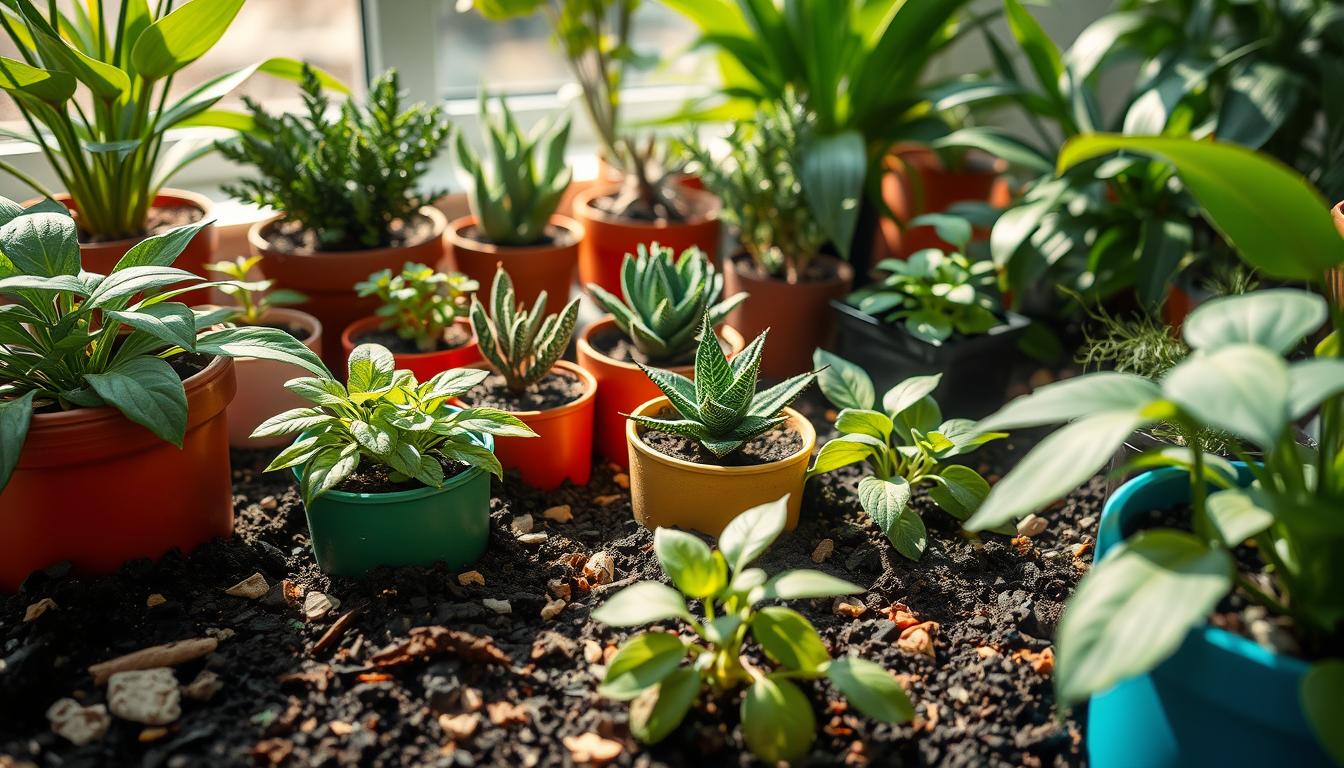I’m excited to share my knowledge on choosing the best soil for indoor plants. As someone who loves indoor plants, I know good soil is key. With many options, picking the right one can be tough. In this article, I’ll help you pick the best soil for your houseplants, considering the type of plants and their needs.
Choosing the right soil for indoor plants involves several factors. I’ll talk about the benefits of organic and inorganic soil. I’ll also cover the different types of soil out there. This guide is for both new and experienced indoor plant owners. It will help you make a smart choice for your plants.
Next, we’ll explore indoor plant soil options in more detail. I’ll share the benefits of organic soil and why drainage is crucial. We’ll cover everything you need to know to create a thriving indoor garden. Let’s start our journey to find the perfect soil for your indoor plants.
Understanding Indoor Plant Needs
Exploring indoor plants, I’ve learned that knowing their needs is key. The right soil is vital for their health. It must hold water, let air in, and feed the roots.
For tropical plants, a moist soil is best. Succulents need soil that drains well to avoid rot. Flowering plants need a mix that supports growth and blooms.
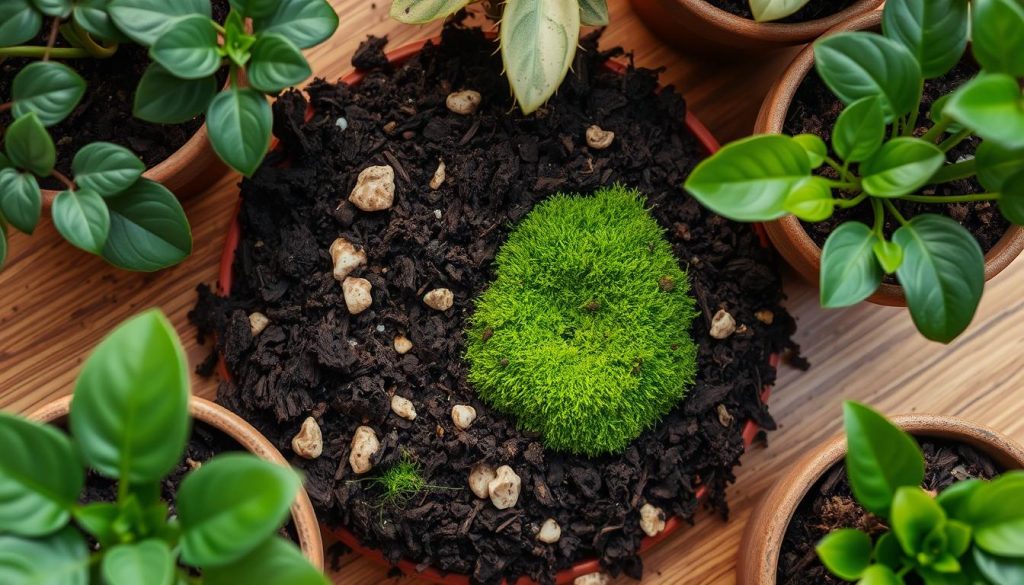
- Tropical plants: high humidity, moisture-retentive soil
- Succulents: well-draining soil, low humidity
- Flowering plants: balanced mix of nutrients, moderate humidity
Knowing what your plants need helps create a vibrant indoor garden. It’s important for both new and experienced gardeners. The right soil mix is crucial for your plants’ health and happiness.
| Plant Type | Soil Preference |
|---|---|
| Tropical Plants | Moisture-Retentive Soil |
| Succulents | Well-Draining Soil |
| Flowering Plants | Balanced Mix of Nutrients |
Types of Soil for Indoor Plants
Choosing the right soil for indoor plants is key. Different soils affect plant health and growth. We’ll look at potting mix, garden soil, and specialty blends.
Potting Mix vs. Garden Soil
Potting mix and garden soil are common for indoor plants. Potting mix offers good drainage and aeration. Garden soil might not have these benefits. Think about your plants’ needs and how much care you can give.
Specialty Blends for Specific Plants
Some plants need special soil to do well. Cacti and succulents need well-draining soil. Orchids and bromeliads prefer acidic, organic-rich soil. Specialty blends meet these needs.
Houseplant soil types with nutrients are popular. Organic indoor plant soil is also favored for its natural ingredients and eco-friendliness.
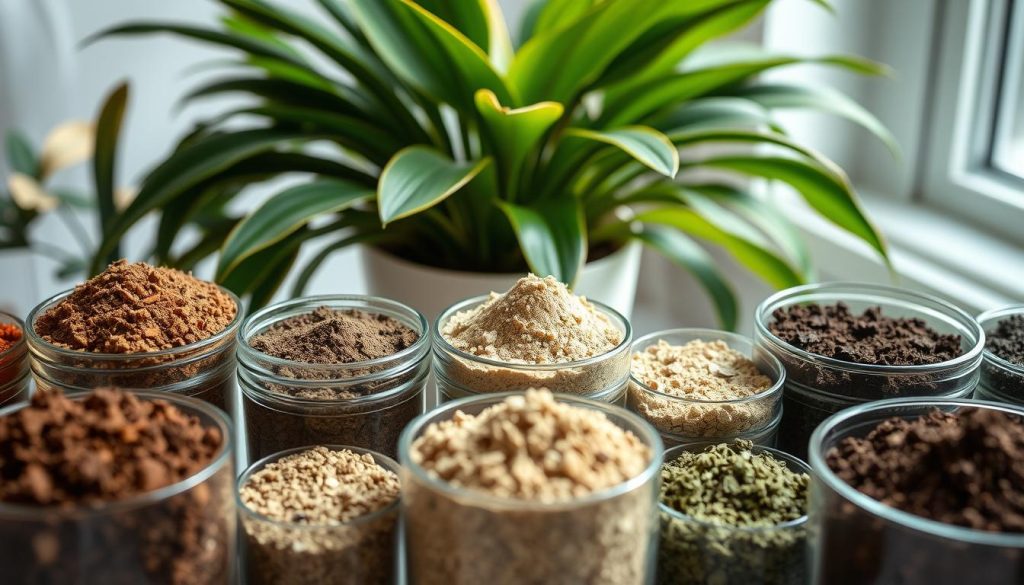
Organic vs. Inorganic: What’s Best?
Choosing between organic and inorganic soil depends on several factors. Organic soil is natural and sustainable. Inorganic soil might offer quicker results but isn’t as eco-friendly. Your choice should match your gardening goals and values.
| Soil Type | Benefits | Drawbacks |
|---|---|---|
| Potting Mix | Good drainage and aeration | May be more expensive than garden soil |
| Garden Soil | Less expensive than potting mix | May not provide good drainage and aeration |
| Specialty Blends | Provide specific nutrients and conditions for plants | May be more expensive than other options |
Key Ingredients in Quality Potting Soil
Choosing the right soil for indoor plants is key. A good mix can make your plants thrive. Let’s look at peat moss, perlite, and vermiculite’s roles in indoor plant soil.
Peat Moss: Benefits and Drawbacks
Peat moss is a favorite in many potting mixes. It keeps moisture in, fights weeds, and controls soil temperature. But, it can be too acidic for some plants. Look for mixes that balance peat moss with other ingredients.
Perlite and Vermiculite: When to Use Them
Perlite and vermiculite are crucial in quality potting soil. Perlite helps with drainage, while vermiculite holds moisture and nutrients. Mixing these with peat moss creates a balanced soil for indoor plants. This mix is perfect for indoor gardening.
Here is a table summarizing the key ingredients in quality potting soil:
| Ingredient | Benefits | Drawbacks |
|---|---|---|
| Peat Moss | Retains moisture, suppresses weeds, regulates soil temperature | Can be acidic |
| Perlite | Improves drainage | None |
| Vermiculite | Retains moisture and nutrients | None |
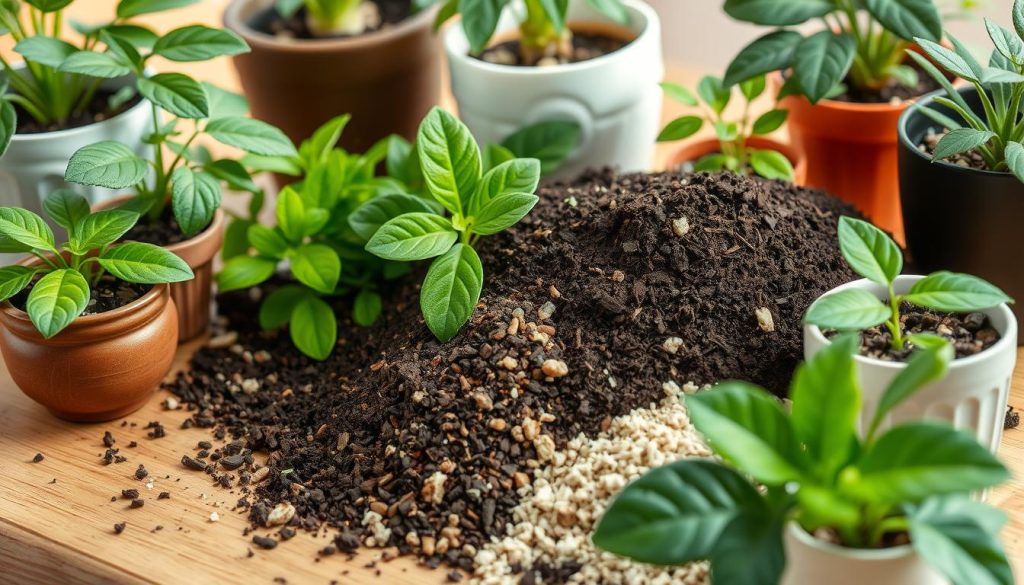
Choosing the Right Potting Mix for Your Plants
Choosing the right potting mix for indoor plants is key. Consider your plants’ types, needs, and whether to use a pre-mixed soil or make your own. A good mix balances nutrients, moisture, and aeration for healthy plants.
A quality indoor potting soil is crucial for your plants’ health. Look for a mix made for indoor plants. It should include peat moss, perlite, and vermiculite. These help with moisture, prevent waterlogging, and ensure good drainage and aeration.
Factors to Consider for Your Indoor Plants
- Type of plants: Different plants need different soils, so choose wisely.
- Moisture levels: If you often overwater, pick a mix that prevents waterlogging.
- pH levels: Some plants like acidic or alkaline soil, so match the mix to their needs.
Tips for Mixing Your Own Soil
Mixing your own soil can save money and be rewarding. Start with peat moss or coconut coir. Add perlite, vermiculite, and fertilizer for a balanced mix. Adjust pH and moisture levels for your plants’ needs.
Using the best potting mix for indoor plants creates a healthy environment. Consider the factors and tips for mixing your own soil. This way, you give your plants the best start.
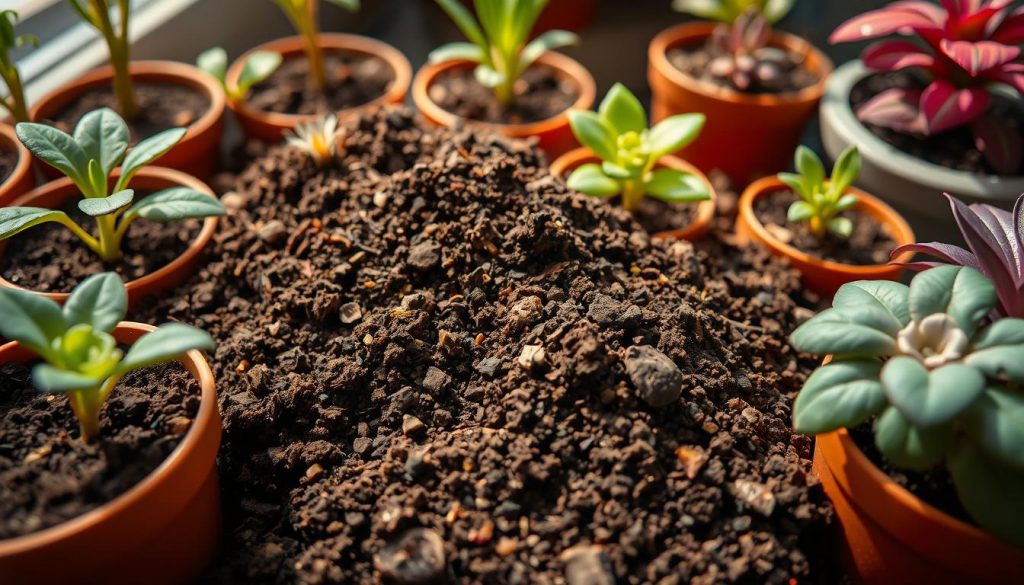
| Potting Mix | Ingredients | Benefits |
|---|---|---|
| General Purpose Mix | Peat moss, perlite, vermiculite | Good drainage, aeration, and moisture retention |
| Seed Starting Mix | Peat moss, vermiculite, fertilizer | Optimal conditions for seed germination and seedling growth |
| Orchid Mix | Bark, sphagnum moss, perlite | Good drainage and aeration for orchid roots |
Understanding Drainage and Aeration
Creating a balanced soil mix for indoor plants is key. Good drainage stops waterlogged soil, cuts down root rot risk, and boosts root health. I’ve tried many houseplant soils and know how vital it is to get it right.
Choosing the right indoor plant soil nutrients is crucial. The type of organic indoor plant soil you pick matters too. It affects drainage and aeration. By understanding your plants’ needs and picking the right soil, you can create the best growing space.
Importance of Good Drainage
Good drainage is essential for healthy plant growth. Waterlogged soil can cause root rot and other issues. To prevent this, choose a soil that drains well and offers good aeration. Here are some tips to improve drainage and aeration in your soil mix:
- Use a well-draining potting mix specifically designed for indoor plants
- Add organic matter like perlite or vermiculite to improve soil structure
- Avoid overwatering, which can compact the soil and reduce drainage
How to Test Drainage in Your Pots
Testing drainage in your pots is easy. It helps you spot any problems. By checking soil moisture and drainage, you can adjust your watering and soil mix. This ensures your plants thrive.
Signs of Poor Soil Quality
As someone who loves indoor plants, I’ve learned it’s key to spot poor soil quality. The right soil is vital for your plants’ health. I’ll talk about signs like yellow leaves and mold, and how to fix them with the right soil.
Some common signs of poor soil quality include:
- Yellowing leaves, which can be a sign of overwatering or nutrient deficiency
- Mold growth, which can indicate poor drainage or high humidity
- Slow growth, which can be a sign of inadequate nutrients or poor soil structure
To avoid these problems, pick a high-quality potting mix. This mix should match your plants’ needs. By choosing the right soil, you create a healthy space for your plants. A good potting mix is essential for your plants’ growth.
| Soil Type | Characteristics | Suitable for |
|---|---|---|
| Potting Mix | Well-draining, nutrient-rich | Most indoor plants |
| Garden Soil | Dense, high clay content | Outdoor plants, not recommended for indoor use |
| Specialty Blends | Customized for specific plant types | Orchids, cacti, and other specialty plants |
Repotting and Refreshing Soil
As an indoor plant lover, I’ve learned that repotting and refreshing soil is key. This means moving your plants to a new pot with fresh soil. This soil gives them the nutrients they need and helps their roots grow.
When picking the best soil, look for one that drains well but also holds moisture. This is important for indoor plants.
To know when to repot, watch for signs like slow growth or yellow leaves. Most indoor plants need a new pot every 1-3 years. When you repot, gently remove the plant, check the roots, and trim any dead ones. Then, put the plant in a new pot with good draining soil and water it well.
Here are some key things to remember for repotting and refreshing soil:
- Choose a pot that’s only 1-2 sizes bigger than the old one to avoid too much water.
- Pick a high-quality indoor soil mix made for indoor plants.
- Water your plants well after repotting and keep an eye on their moisture.
By following these tips and using the right soil, you can help your plants grow and stay healthy. Remember to change the soil often to keep it fresh and prevent toxins. With the right care and soil, your indoor plants will flourish and add beauty to your home.
| Plant Type | Repotting Frequency | Soil Preference |
|---|---|---|
| Herbs | Every 6-12 months | Well-draining indoor potting soil |
| Succulents | Every 1-2 years | High-quality indoor gardening soil mix |
| Ferns | Every 2-3 years | Moisture-retentive indoor potting soil |
Sustainable Practices for Indoor Plant Soil
As someone who loves indoor plants, I’m always searching for ways to help the environment. Using homemade compost and organic soil amendments is a big part of that. These methods help reduce waste and save resources.
Using Homemade Compost
Making your own compost is a smart move. Start by collecting kitchen scraps like fruit and veggie peels. Put them in a compost bin. Over time, they turn into a rich soil amendment for your plants.
Benefits of Organic Soil Amendments
Organic soil amendments, like compost and manure, are great for your plants. They improve soil structure and help it hold water better. They also support good microorganisms. This makes for a healthy, eco-friendly indoor garden.
Some top organic soil amendments for indoor plants are:
- Compost
- Worm castings
- Manure tea
These can be mixed with different houseplant soils to make a balanced, nutrient-rich mix. By using these methods, you can grow a vibrant, eco-friendly indoor garden.
Resources for Finding Quality Soil
Looking for the best soil for your indoor plants? There are many trusted brands and sources to explore. Miracle-Gro, Black Gold, and Fox Farm are among the top choices. They offer high-quality, nutrient-rich formulas that meet the needs of houseplants.
Recommended Brands for Indoor Plant Soil
Miracle-Gro Potting Mix and Black Gold Natural & Organic Potting Soil are top picks for me. They’re full of essential minerals and offer great drainage, aeration, and moisture retention. These are key for indoor plants to thrive.
Local Stores VS Online Options: What I Found
Shopping locally at garden centers or home improvement stores can be beneficial. You get a wider selection and can check the soil before buying. But, online stores like Amazon or specialty plant websites are great for specific blends or hard-to-find soils. It’s all about finding the right soil for your plants, whether locally or online.

